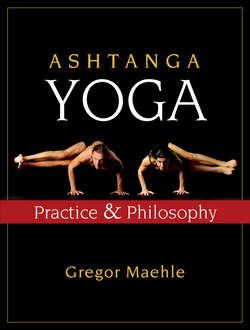Читать книгу Ashtanga Yoga - Gregor Maehle - Страница 168
На сайте Литреса книга снята с продажи.
Vinyasa One
ОглавлениеSince this is a surprisingly complex posture, we will break it down into phases. Beginners should study these phases closely.
PHASE 1
Inhaling, lift the right knee to the height of the chest and draw the heel to the right sit bone. To do the posture safely, we have to be able to touch the sit bone with the heel. This means that we have completely closed the gap between femur and tibia. Only then can the two bones move as a unity in the posture, which avoids any strain on the knee joint. If you cannot perform this movement, you should not attempt to go all the way into the posture, but concentrate instead on preparation. If you cannot completely close the knee joint you need to lengthen the quadriceps. Long quadriceps are also of great advantage in backbending.
PHASE 2
Pick up the right foot and, cradling it in both hands, point and invert it. Now direct the knee far out to the side. Gently draw the foot up into the right groin, with the knee still out to the side. This educates the hip to perform lateral rotation. The main prerequisite for the lotus and half-lotus postures is the ability to rotate the femur in the hip joint, and resistance may be encountered here. It is important to realize that the half-lotus and lotus postures belong to a group that involve hip rotation and not knee rotation. If we do not open the hip joints (which are ball-and-socket joints and move in all directions), the “opening” will go into the knee joints. These are, however, hinge joints, designed to move in only one direction. The “opening” will be nothing but a destabilization.
The ancient yogis had no problems in this area: they always sat on the floor, which keeps the hip joints mobile and flexible. In our society we sit in chairs off the floor and with the hip joints flexed. We therefore need to invest extra time into postures that prepare us for the Primary Series.
PHASE 3
From having the knee pointed far out to the right and the right heel in the right groin, we now lift the heel toward the navel, keeping foot and knee the same distance from the floor.
If you closed the gap between tibia and femur, both bones will now move as a unity, preventing any strain on the knee joint. I like to refer to this knee position as “sealed.” It ensures that the rotation happens between the femur and its hip socket (acetabulum) and not between the femur and the tibia (knee joint). When you have acquired the necessary hip rotation, you will be able to touch your heel to your navel.
